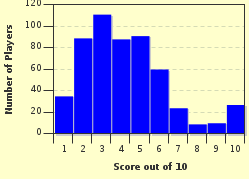Quiz Answer Key and Fun Facts
1. Which of the following does saliva not contain?
2. Bile is partially produced by breakdown products of which of the following?
3. Cerebrospinal fluid contains sugar.
4. Which of the following help(s) to control the growth of fungus on the skin?
5. What is the "ejection fraction"?
6. Which of the following is not true of the pineal gland?
7. Which organ is not matched with its correct shape?
8. The ovaries are connected to the Fallopian tubes.
9. Which of the following associations are incorrect?
10. Ever wonder how the body knows to make muscle cells bigger because we exercise? I have. Since muscle cells do not tend to divide, they must enlarge to add muscle mass. Name another cell type which does not tend to divide, but gets bigger or smaller depending on certain factors.
Source: Author
jstagamtome
This quiz was reviewed by FunTrivia editor
crisw before going online.
Any errors found in FunTrivia content are routinely corrected through our feedback system.


